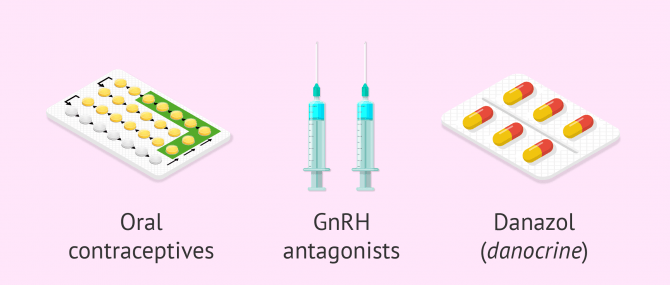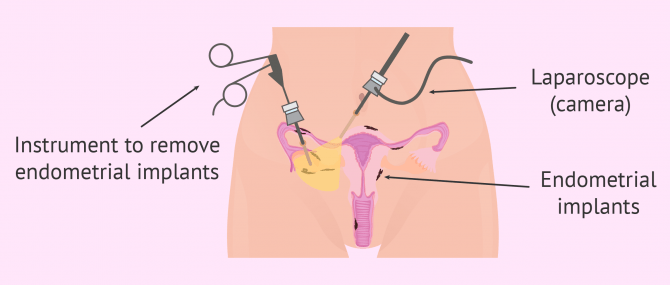Endometriosis, commonly known as endo, is an invasive condition that causes endometrial tissue to grow outside the uterine cavity, in places such as the Fallopian tubes or the ovaries.
It affects about 10-15% of women of childbearing age and can affect female fertility by reducing the chances for natural pregnancy to occur and the pregnancy rates in the case of women who undergo fertility treatment due to the presence of endometrial cysts.
In the most severe cases, that is, when a woman is diagnosed with severe endometriosis, getting pregnant may not be possible and, for that reason, using a surrogate could be the only option of choice to have biological children.
Provided below is an index with the 8 points we are going to expand on in this article.
- 1.
- 1.1.
- 1.2.
- 1.3.
- 2.
- 2.1.
- 2.2.
- 3.
- 3.1.
- 3.2.
- 3.3.
- 4.
- 4.1.
- 5.
- 5.1.
- 5.2.
- 5.3.
- 5.4.
- 5.5.
- 5.6.
- 6.
- 7.
- 8.
Definition
Endometriosis is a chronic condition that appears in women and involves the presence of abnormal outgrowths in the uterine lining (endometrium), that is, the inner layer of the womb, particularly around the organs that surround the pelvic cavity.
Typically, endometriosis is located nearby the Fallopian tubes (tubal endometriosis) or the ovaries (ovarian endometriosis), where a type of cysts known as chocolate cysts due to their appearance grow.
Nonetheless, endometrial implants can appear in other places like the intestine, the lungs, or even the brain, although this type of endometriosis is uncommon.
Stages
The stages of endometriosis have been classified by the American Society for Reproductive Medicine (ASRM) into several grades that you can find explained hereunder:
- Stage 1 (minimal)
- isolated implants are found superficially, without adhesions.
- Stage 2 (mild)
- characterized by the growth of superficial implants of around 5 cm. They tend to grow in the peritoneum and the ovaries, but may affect other organs too.
- Stage 3 (moderate)
- Several implants are detected and they can be superficial or invasive. They grow around the Fallopian tubes and ovaries.
- Stage 4 (severe)
- A large number of cysts and severe adhesions are present.
As one shall see, the degree of severity depends on the location, profundity, quantity, and size of the adhesions.
Symptoms
The most common symptom of endometriosis is pain during menstrual periods, as the outgrowths have their origin in the womb. In other words, endometrial tissue is also affected by hormones throughout the menstrual cycle.
When the woman gets her periods, endometrial implants start bleeding, which causes inflammation and formation of scar tissue, finally causing endometrial adhesions.
The following are the potential symptoms caused by stage 4 or severe endometriosis:
- Pelvic, abdominal and lower back pain
- Bloody urine during periods
- Tiredness, fatigue and back pain
- Painful intercourse
- Heavy menstrual periods and intermenstrual bleeding
- Emotional alterations due to being unable to lead a normal lifestyle and fertility issues
In spite of all these symptoms, about 20-30% of women who suffer from endometriosis have no symptoms or discomforts associated with the disease. Most of them get a diagnosis of endo after having been trying to conceive for some time without luck and deciding to visit a fertility specialist.
Diagnosis
Although there exist many techniques to diagnose endometriosis, the following are the most commonly used ones:
- Physical exploration
- If you experience symptoms like pain or you think you may have endometriosis, your OB/GYN will conduct a complete pelvic exam in order to find signs associated with endometriosis, including implants or stuck ovaries, tubes, and womb.
- Ultrasound scan
- It allows the specialist to visualize the organs located in the pelvic area in order to detect the presence of potential ovarian cysts, such as endometrial or chocolate cysts.
- Blood test
- tumor marker Ca-125 is elevated in women with endometriosis, especially when there is presence of endometrial cysts in the ovary.
- Laparoscopy
- It is the most accurate test to detect endometriosis, as it is seen using a camera that is inserted directly through the abdomen doing a small incision.
Actually, detecting endometriosis is complicated, as it is often associated with an extensive clinical picture that is in most cases accompanied by a wide range of symptoms.
Endometriosis & infertility
As explained above, endometriosis is a common disease among women of reproductive age. Out of them, about 40% suffer experience trouble getting pregnant.
What follows are the main reasons why endometriosis can affect the female reproductive system:
Alterations of reproductive organs
Endometriosis affects mainly the ovaries and the Fallopian tubes, due to their proximity to the uterus.
As regards the ovaries, endometrial adhesions and chocolate cysts destroy the tissue that is healthy and reduce the egg count. Moreover, the presence of endometrial tissue inhibits follicle growth and ovulation.
Also, endometriosis causes a blockage in the tubes, which translates into the sperm cell to be unable to reach the egg cell and fertilize it.
For this reason, many women with endometriosis have no choice but to turn to an infertility treatment to have a baby, like In Vitro Fertilization (IVF) or egg donation.
Alterations of endometrial receptivity
Endometriosis can also give rise to alterations in the immune system, including increased levels of T lymphocytes, as well as IgG and IgA antibodies. This can affect endometrial receptivity and subsequently the embryo's implantation potential.
Also, women with endometriosis have issues with the synthesis of the round ligament of the uterus and have poor levels of α (alpha) and β (beta) integrins, both necessary for embryo implantation.
Treatment
First and foremost, it should be clear that there is no cure for endometriosis. The potential treatment options are used to alleviate the symptoms and try to deal with infertility.
Depending on the location of endometrial implants, stage of severity and symptoms, the treatment will vary on a case-by-case basis. Other aspects such as age and if she wants to have children in the near future should be taken into account, too.
Pain medications
In the case of women with stage 1 or 2 endometriosis (minimal or mild), painkillers can help you deal with pain.
Painkillers are prescribed only to women who have pelvic pain occasionally. If you experience pain on a regular basis, that is, it is present in all your menstrual cycles, you should visit your OB/GYN to monitor the development of the condition.
Hormone treatment
Women with mild to moderate endometriosis who are not considering starting a family presently, the combined oral contraceptive pill is highly recommendable. The reduction in the menstrual flow causes the symptoms to improve. Unfortunately, this advantage will disappear as soon as you stop taking the pill.
Other fertility drugs such as GnRH agonists, which inhibit menstruation and prevent the growth of endometrial implants, can work as well. This hormone replacement therapy should be used for a maximum time period of about 6 months. As in the case of the pill, symptoms reappear after stopping treatment.
Finally, danazol, also known as danocrine, is a very common therapy for the treatment of endometriosis. It is a synthetic hormone derived from testosterone that inhibits ovulation and the menstrual cycle.
Although you may still have a slight menstrual flow in spite of using danazol, your periods are likely to stop eventually. Your normal periods will resume within 2 months as soon as you stop treatment.
Along with danazol, these women should use birth control in order not to become pregnant, as this drug may damage the fetus.
Surgery
When endometriosis becomes severe or if the woman has an unbearable pain, endometrial implants can be removed with surgery.
The most commonly used surgical procedures to treat endometriosis include:
- Laparoscopy
- It is a minor surgical procedure that allows your doctor to remove the endometrial implants through a small incision.
- Laparotomy
- It is a more aggressive procedure that requires a larger abdominal incision. It is used in cases of severe endometriosis or when the implants cannot be reached through laparoscopy.
- Hysterectomy
- It involves the complete removal of the uterus to eliminate the disease permanently. Depending on the damage caused, the ovaries and tubes may be removed as well.
The latter option is taken into account only in the most severe cases or when the patient has no intention of having children in the future.
Getting pregnant
Women affected by endometriosis who cannot achieve pregnancy naturally, even after surgery, have no alternative but to turn to Assisted Reproductive Technology (ART) in order to have a baby.
Based on factors such as age, sperm quality, stage of endometriosis, etc., the most adequate treatment option can be:
- Intrauterine Insemination (IUI)
- The first option for young women with minimal or mild endometriosis (stage 1 or 2), as long as tubal patency is okay.
- In Vitro Fertilization (IVF)
- Pregnancy rates are higher and it is the technique of choice in cases of moderate to severe endometriosis (stages 3 and 4).
- Egg donation
- Women with stage 4 endo whose egg supply is severely affected, egg quality is too low, endometrial implants are so large that egg retrieval cannot be performed, or have experienced several failed IVF cycles can become mothers thanks to donor eggs.
You may also enjoy some further information reading this: Can You Get Pregnant with Endometriosis? – Your Chances of Success.
Using a gestational surrogate
In the most severe forms of endometriosis, the disease may become a contraindication to pregnancy or cause the woman to be totally incapable of getting pregnant.
Reproductive options for women with endo who cannot carry a child until birth include adoption and gestational surrogacy.
What follows is a list of some reasons why a woman affected by endometriosis may need to use a gestational carrier (GC) to have a child:
- Has had a hysterectomy, that is, she's got no uterus
- A pregnancy would cause endometrial implants to grow massively
- Repeated implantation failure with every IVF attempt, both using own and donor eggs
- Recurrent miscarriages
Surrogacy is a third party reproduction option whereby a woman (the gestational carrier or surrogate) carries a child for someone else (i.e. intended parent) until birth.
Based on whether the intended mother still has ovaries or can use her own eggs, the aid of an egg donor may be required or not. In either case, the GC cannot use her oocytes for the process.
Click here to read more: What Is Surrogacy & How Does It Work? – Everything You Should Know.
Surrogacy is the assisted reproduction treatment that generates the most deception and doubts. Therefore, it is essential to choose a clinic and an agency that transmits transparency and avoids deception.
FAQs from users
What is the best treatment option to cure endometriosis and be able to get pregnant?
Endometriosis is a chronic condition and there is no cure. Surgery to excise and/or ablate endometriosis can increase the chance of pregnancy, but repeat surgeries are not successful. The treatment of choice depending on the age of the woman and the extent of the endometriosis includes ovulation induction with IUI’s and IVF. IVF is more successful but is also more costly and is not as available.
Can severe endometriosis cause miscarriage?
Yes. Damage to the tubes from endometriosis can cause the fertilized egg to implant in a place other than the uterine lining, causing an ectopic pregnancy and subsequently leading to miscarriage.
However, the reason behind the link between endometriosis and miscarriage is not particularly clear yet. Several studies have been conducted, though with conflicting outcomes.
Can severe endometriosis lead to cancer?
Yes, there is evidence that endometriosis increases the risk of developing cancer later in life, particularly ovarian cancer. The cause is not fully understood yet, though. Endo has also been linked with other types of cancer, including lymphoma and breast cancer, according to the Endometriosis Foundation of America (EFA).
What does severe endometriosis look like?
Chocolate cysts (endometriomas) begin to appear in the third stage of endometriosis (moderate) and increase in size in the fourth stage (severe). The name is due to the aspect of endometriomas, as the blood inside of the cysts turns dark red and brown after some time.
If one of these cysts ruptures, the pelvic region can look swollen and the risk of infection increases, which in turn increases the risk of adhesions to proliferate.
In the final stage of endometriosis (stage 4), endometriomas look as big as a grapefruit. In fact, at this point, endometriomas over the size of 2 cm are usually surgically removed. Many of these cysts are located on the rectum and the back wall of the uterus, thereby causing digestive issues.
How does endometriosis affect pregnancy?
As a matter of fact, during pregnancy, endometriosis can improve or alleviate the symptoms, but it may come back later and cause problems becoming pregnant again in the future. If you get pregnant with endometriosis, it's important that you don't miss all the regular check-ups as instructed by your doctor or midwife.
How soon can severe endometriosis return?
After surgery, the chances for endometriosis to return depend on several factors that can vary on a case-by-case basis, including: immune system status, nutritional status, percent of body fat, smoking status, medications, stress, compliance with post-op directions, etc. If you suspect that endometriosis is back, you should visit your doctor as soon as possible.
Suggested for you
As we have explained above, endometriosis is considered a contraindication to pregnancy in the most severe forms of the disease. To learn more about other medical contraindications to pregnancy, check this out: Medical Contraindications to Pregnancy – When to Use a Surrogate.
Also, endometriosis is a condition that affects the uterus and female reproductive system, which leads to female infertility. If you want to learn more about infertility of uterine origin, read: Uterine Factor Infertility – Diseases & Anomalies that Cause Infertility.
We make a great effort to provide you with the highest quality information.
🙏 Please share this article if you liked it. 💜💜 You help us continue!
References
FAQs from users: 'What is the best treatment option to cure endometriosis and be able to get pregnant?', 'Can severe endometriosis cause miscarriage?', 'Can severe endometriosis lead to cancer?', 'What does severe endometriosis look like?', 'How does endometriosis affect pregnancy?' and 'How soon can severe endometriosis return?'.
Authors and contributors







Can endometriosis turn into cancer when not being treated? I’ve had endometriosis since in puberty but the only treatment I got was anticonceptives. Dunno if it’s sufficient. Maybe someone is able to clear my doubts. greets